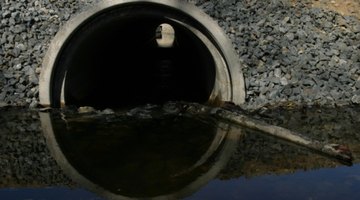How to Clean a Culvert Pipe
A culvert is a section of pipe used to divert water under a driveway or road. It receives water from the system of ditches designed to collect storm water runoff from the surrounding area. Thus they tend to collect dirt and debris that’s washed into the ditches.

If this debris builds up too much, the culvert can become blocked and cause flooding in the local area.
The tricky part of cleaning a culvert pipe is finding a tool with a long enough reach.
Things You Will Need
- Shovel
- 15-foot length of heavy wall pipe sized to attach to the shovel head
- Commercial culvert clean-out tool
- Pressure washer
- 55 gallon barrel with hose fittings
- Garden hose
-
Before you start this job, find out if you can avoid it! Call your local municipality. If the culvert is on a road maintained by the city or county, they may send out a crew with power-assisted equipment. If you’re in an area with a volunteer fire department, try to work out a deal where you make a donation to the department and they come out and solve your problem in a jiffy with a burst of high-pressure water.
-
Make a 15 foot-long shovel by welding a heavy walled pipe to a shovel end. This tool can be hard to manage, but it does work. Take the pieces to a local shop and have them weld them together. (Sometimes a local high school metal shop can do it for you.)
-
If you want to make the work easier, buy a culvert-cleaning tool specially designed for the job. This tool has a hoe-type head with a pivoting joint. You push it into the culvert on top of the debris. When you pull the tool back out, the pivoting joint on the head is activated, and the pulling action makes the tool dig down into the silt and debris.
-
If the long hand tools are not enough to do the job, use a pressure washer to force the dirt and debris out.
-
If you don’t have a water supply where your culvert is, connect the pressure washer to 55 gallon barrel of water positioned so that it is higher than the washer. Fit the barrel with hose fittings and connect it to the pressure washer with a garden hose.
-
Once you’ve cleared your culvert, haul off any debris that’s piled up at either end. This prevents the debris from re-entering your culvert or washing downstream to the neighbor’s culvert.
Tip
Check your culvert routinely to prevent minor buildups from escalating into a totally clogged pipe. The Oregon Association of Clean Water Agencies recommends inspecting culverts every five years. Check out your culvert to see if it’s designed to do the job properly. According to the University of Nevada, “a clean, properly functioning culvert is big enough to handle storm flows; its bottom is at the same level as the bottom of the ditch; its inlet and outflow are not blocked, and the banks of the ditch are protected from erosion.”
The Drip Cap
- A culvert is a section of pipe used to divert water under a driveway or road.
- Thus they tend to collect dirt and debris that’s washed into the ditches.
- If the long hand tools are not enough to do the job, use a pressure washer to force the dirt and debris out.
- Fit the barrel with hose fittings and connect it to the pressure washer with a garden hose.
- Once you’ve cleared your culvert, haul off any debris that’s piled up at either end.
References
Writer Bio
With a background in mechanical engineering, writing, and web production, Rosy Tyler finds many things interesting. Her passions are green building and creating websites that are both beautiful and logical.
Photo Credits
- Jupiterimages/Photos.com/Getty Images
- Jupiterimages/Photos.com/Getty Images
More Articles


